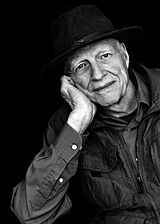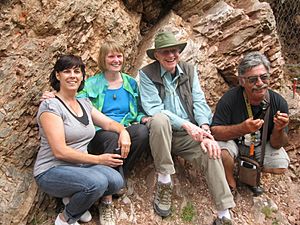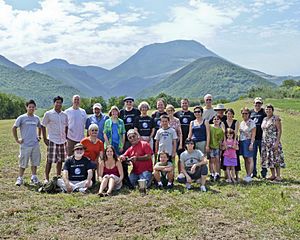Walter Alvarez facts for kids
Quick facts for kids
Walter Alvarez
|
|
|---|---|

Walter Alvarez at his home in 2024
|
|
| Born |
Walter Alvarez
October 3, 1940 |
| Alma mater |
|
| Known for | Alvarez hypothesis |
| Spouse(s) |
Milly Alvarez
(m. 1963) |
| Parent(s) |
|
| Awards |
|
| Scientific career | |
| Fields | Geology |
| Institutions | |
Walter Alvarez, born on October 3, 1940, is a well-known professor. He teaches in the Earth and Planetary Science department at the University of California, Berkeley. He and his father, Nobel Prize-winning physicist Luis Alvarez, developed a very important idea. They suggested that a giant asteroid hitting Earth caused the dinosaurs to die out. This idea changed how many scientists understand Earth's past.
Contents
Walter Alvarez's Life Story
Early Life and Education
Walter Alvarez was born in Berkeley, California. His father, Luis Walter Alvarez, was a famous physicist who won a Nobel Prize. Walter's family included many interesting people. His grandfather, Walter C. Alvarez, was a doctor. His great-grandfather, Luis F. Alvarez, also a doctor, worked in Hawaii. Walter's great-aunt, Mabel Alvarez, was a talented artist.
Walter loved studying the Earth. He earned his first degree in geology from Carleton College in 1962. He then continued his studies, getting his Ph.D. in geology from Princeton University in 1967.
Working Around the World
After finishing his education, Walter worked for an oil company. He worked in the Netherlands and in Libya. While there, he became very interested in how geology connects with old human settlements. He left the oil company to study Roman volcanoes in Italy. He wanted to see how these volcanoes affected where people built their towns long ago.
Later, Walter joined the Lamont–Doherty Earth Observatory at Columbia University. He began studying the movement of Earth's plates in the Mediterranean Sea. This work, called plate tectonics, helped him understand how the Earth's surface changes. He also studied ancient magnetic changes in rocks. This helped him date events in Earth's history over millions of years.
The Asteroid Impact Theory
Walter Alvarez and his father, Luis W. Alvarez, made a huge discovery. They worked with scientists Frank Asaro and Helen Michel. They found a special layer of clay in rocks that was very rich in a metal called iridium. This layer was found exactly at the time when dinosaurs disappeared, about 66 million years ago.
Iridium is very rare on Earth's surface but common in asteroids. So, they suggested that a huge asteroid hit Earth. This massive impact caused the Cretaceous–Paleogene extinction event. This event led to the disappearance of 75% of all living things, including all non-bird dinosaurs.
Scientists have since found this iridium layer in many places worldwide. Also, a giant crater was found off the coast of Mexico. This crater, called the Chicxulub crater, is now seen as strong proof of the asteroid impact. Today, most scientists agree that an asteroid impact caused the dinosaur extinction. Walter Alvarez wrote a book about this discovery called T. Rex and the Crater of Doom in 1997.
Besides his work on extinctions, Alvarez has also helped us understand:
- How Earth's plates move in the Mediterranean.
- The geology of Ancient Rome.
- How to use magnetic changes in rocks to date Earth's history.
Exploring Big History
What is Big History?
In 2006, Walter Alvarez started teaching a new course at UC Berkeley. He called it "Big History: Cosmos, Earth, Life, Humanity." He taught this course until 2011. The lectures were recorded and made available for free online.
According to Alvarez, Big History tries to understand the entire story of everything. This includes the history of the universe, Earth, life, and humans. It connects different subjects like science, history, and more. This definition was later used by the International Big History Association (IBHA). Alvarez's course helps students get a broad understanding of the past, present, and future.
Creating the IBHA
Alvarez helped organize a meeting of Big History thinkers in Italy in 2010. This meeting led to the creation of the International Big History Association. The IBHA is a non-profit group. Alvarez was one of its first members and served on its advisory board until 2014.
ChronoZoom: A Timeline Tool
Walter Alvarez also worked with Microsoft Research to create a special tool called ChronoZoom. This tool is like a zoomable timeline on a computer. It helps people see and understand huge amounts of historical information. It makes it easier to visualize very long periods of time. ChronoZoom was first shown to the public in 2012 at UC Berkeley.
Awards and Recognitions
Walter Alvarez has received many honors for his important work.
- In 1983, he became a Fellow of the American Academy of Arts and Sciences.
- In 1991, he was elected a member of the United States National Academy of Sciences.
- He received the 2006 Nevada Medal.
- He was awarded the 2008 Vetlesen Prize.
- He also received the Penrose Medal from the Geological Society of America.
- In 2005, the University of Siena in Italy gave him an honorary doctorate degree.
There is even a small planet named after him and his father. It is called 3581 Alvarez.
Books by Walter Alvarez
- T. Rex and the Crater of Doom (Princeton University Press, 1997)
- A Most Improbable Journey: A Big History of our Planet and Ourselves (W. W. Norton, 2016)




